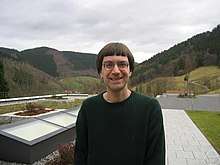Kevin Ford (mathematician)
Kevin B. Ford (born 22 December 1967) is an American mathematician working in analytic number theory.
Kevin B. Ford | |
|---|---|
 | |
| Born | 22 December 1967 |
| Nationality | American |
| Alma mater | California State University, Chico University of Illinois at Urbana-Champaign |
| Known for |
|
| Scientific career | |
| Fields | Mathematics |
| Institutions | University of Illinois at Urbana-Champaign University of South Carolina |
| Doctoral advisor | Heini Halberstam[1] |
He has been a professor in the department of mathematics of the University of Illinois at Urbana-Champaign since 2001. Prior to this appointment, he was a faculty member at the University of South Carolina.
Ford received a Bachelor of Science in Computer Science and Mathematics in 1990 from the California State University, Chico. He then attended the University of Illinois at Urbana-Champaign, where he completed his doctoral studies in 1994 under the supervision of Heini Halberstam. In 2013, he became a fellow of the American Mathematical Society.[2]
Ford's early work focused on the distribution of Euler's totient function. In 1998, he published a paper that studied in detail the range of this function and established that Carmichael's totient function conjecture is true for all integers up to . [3] In 1999, he settled Sierpinski’s conjecture. [4]
In August 2014, Kevin Ford, in collaboration with Green, Konyagin and Tao, .[5] resolved a longstanding conjecture of Erdős on large gaps between primes, also proven independently by James Maynard .[6] The five mathematicians were awarded for their work the largest Erdős prize ($10,000) ever offered. [7] In 2017, they improved their results in a joint paper. [8]
References
- Kevin Ford at the Mathematics Genealogy Project
- List of Fellows of the American Mathematical Society, retrieved 2017-11-03.
- Ford, Kevin (1998). "The distribution of totients". Ramanujan Journal. 2 (1–2): 67–151. arXiv:1104.3264. doi:10.1023/A:1009761909132.
- Ford, Kevin (1999). "The number of solutions of φ(x) = m". Annals of Mathematics. Princeton University and the Institute for Advanced Study. 150 (1): 283–311. doi:10.2307/121103. JSTOR 121103.
- Ford, Kevin; Green, Ben; Konyagin, Sergei; Tao, Terence (2016). "Large gaps between consecutive primes". Annals of Mathematics. 183 (3): 935–974. arXiv:1408.4505. doi:10.4007/annals.2016.183.3.4.
- Maynard, James (2016). "Large gaps between primes". Annals of Mathematics. Princeton University and the Institute for Advanced Study. 183 (3): 915–933. arXiv:1408.5110. doi:10.4007/annals.2016.183.3.3.
- Klarreich, Erica (22 December 2014). "Mathematicians Make a Major Discovery About Prime Numbers". Wired. Retrieved 27 July 2015.
- Ford, Kevin; Green, Ben; Konyagin, Sergei; Maynard, James; Tao, Terence (2018). "Long gaps between primes". Journal of the American Mathematical Society. 31: 65–105. doi:10.1090/jams/876.